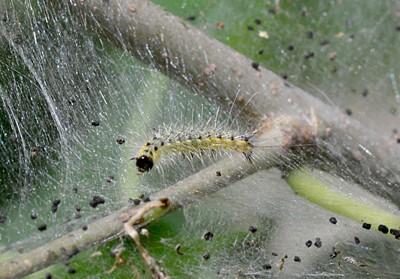Key points
- Fall webworm (Hyphantria cunea) caterpillars may feed on more than 100 species of deciduous forest and shade trees.
- Preferred hosts include mulberry, walnut, hickory, elm, sweetgum, poplar, willow, oak, linden, ash, apple, and other fruit trees.
- The adult moths are about 3/4 inch long. The wings are all white or white with black spots.
- Mature larvae are about 1 inch long and may occur in two color forms: those with black heads are yellowish-white, and those with red heads are brown.
- Both color forms have paired black tubercles running down the back. They are covered with long, silky gray hairs.

Fall webworm. Photo: David L. Clement, University of Maryland

Fall webworm. Photo: David L. Clement, University of Maryland
Damage
- The caterpillars produce a web of fine silk over terminal branches.
- They only feed inside the web, which they enlarge as they grow.
- Look on the south side of tree crowns for the first sign of webbing.
- The webs may become messy, but the caterpillars rarely consume enough terminal growth to affect the tree.
- The first generation begins in May and is usually small. The second-generation caterpillars are present from August through October.
- The dry webs hang on terminals into the winter.
Management
- Prune out webbed terminals as they are detected.
- Pole pruners are useful for removing tents in trees.
- Bt (Bacillus thuringiensis, var. Kurstaki), horticultural oil, or insecticidal soap is recommended to control young larvae in large infestations to protect beneficial insects.
- There are 75 species of predators and parasites that normally keep this pest below damaging levels.
- Never try to burn them out!
Rev. 2020
